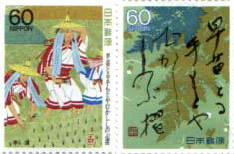
OKU-NO HOSOMICHI, SERIES II
Four 60 yen stamps were issued on June 23, 1987 as OKU-NO HOSOMICHI [The Narrow Road to the Deep North], Series II.

Turn across that moor,
0 horseman, for I hear
A cukoo singing there!
(Trans. D. Briton, A Haiku Journey, Kodansha, 1979)
This haiku was written by Basho during his trip from Kurobane to the spa of Nasu on his long journey round the northern district. Takatsu Johoji, the principal retainer of Obzeki clan had the kindness to prepare Basho a horse and a mago (a road-horse man) for his traveling. Basho tells that he wrote this haiku on a paper strip when he was asked by his mago for it. The substance of the haiku: I was riding on horseback through the vast plain of Nssu accompanied by a mago, when I heard suddenly a merry song of cukoo passing by. "0 my dear mago" I said to him, "Turn the horse toward a cukoo singing over there!"

One whole paddy field
Was planted ere I moved on
From that willow tree!
(Trans. D. Briton)
Basho made this haiku when he visited the "Yu-gyo" willow which stood on the bank of a paddy field nearby Hachiman shrine at Ashino in Nasu. That willow tree was famous for Saigyo’s tanka poetry into which he put it. The substance of the haiku: While I was caught in deep emotion as I watched the willow famed for Saigyn’s poetry and thought of ancient times, peasants finished planting rice seedlings for one paddy field. On being aware of it, I came to myself from meditation and left the willow tree to go on with my journey.
OKU-NO HOSOMICHI, SERIES III
Four 60 yen postage stamps were issued on August 25, 1987 as OKU-NO HOSOMICHI [The Narrow Road to the Deep North], Series III.

People of this world
Notice not its modest blooms
The chestnut by the eaves
(Trans. D. Briton, A Haiku Journey, Kodansha, 1979)
Having passed the station at Shirakawa, Basho called on his old friend Izaemon Sagara (pen name "Tohkyu") a wealthy farmer at Sukagawa and stayed there for some days. One of these days he visited the priesat named Kashin lived in a hermitage under a big chestnut tree. This poem was made at that time. The purport is: The chestnut bloom is an uninteresting one seldom noticed by peoples. With so much love to this chestnut tree the hermit lives an elegant life as if the chestnut tree.

Young hands planting rice!
Erstwhile I see them rubbing
Ferns with equal grace!
(Trans. D. Briton)
Basho made this poem when he visited "Stone of Rubbing Ferns" which is located at a suburb of today's Fukushima. The purport is: Young maidens are planting rice seedling with such a graceful motion. It reminded one of the rubbing ferns of the old days. "Rubbing ferns" were known as a kind of dyed cloth, the product of Shinobu Country in the Oku region. Its "twine" Pattern made the cloth so famous.